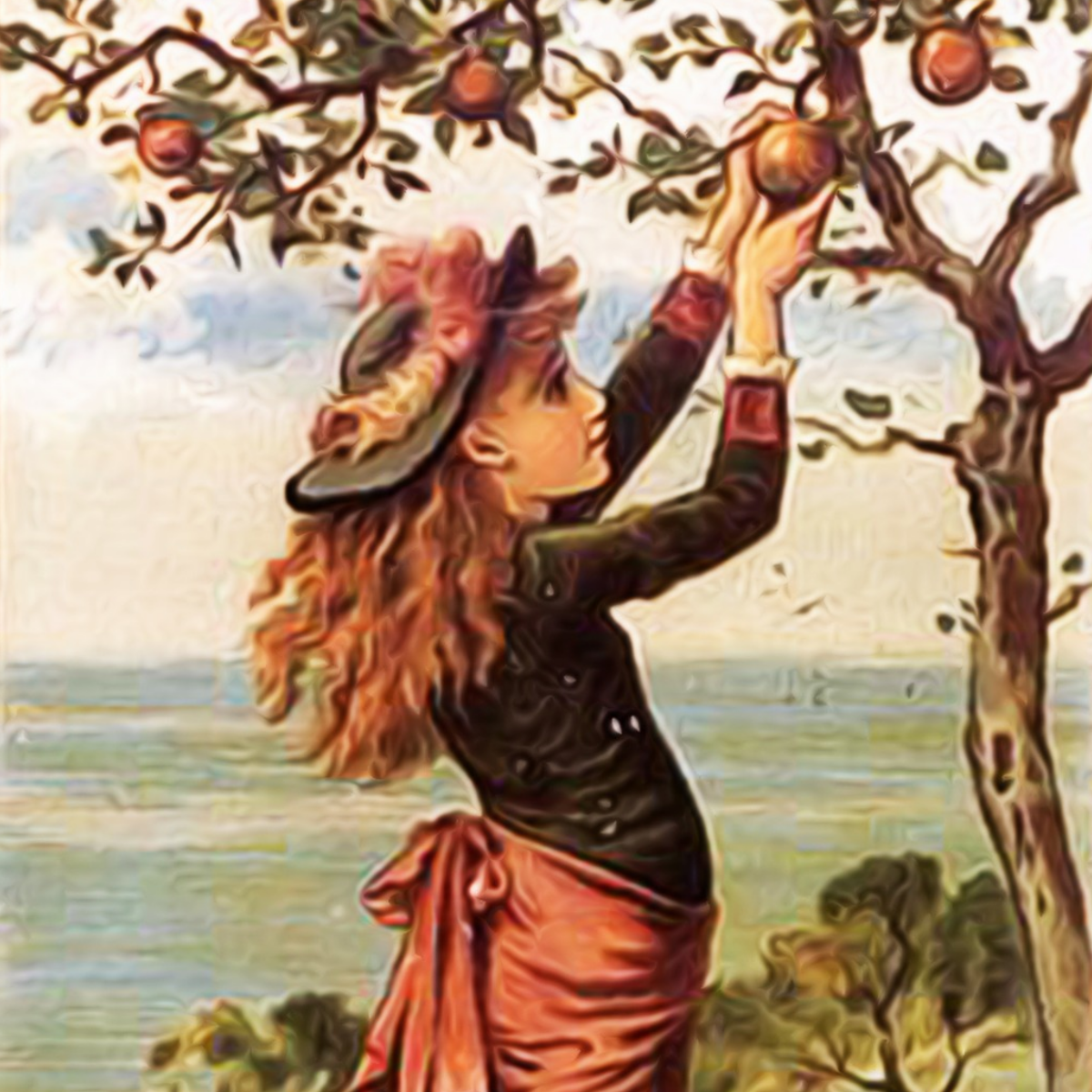When I make my grocery shopping list for holiday dinners and ask my family if they’d like a pie, their eyes grow as large as pie tins, and they answer with a resounding, “Yes!” When I ask what flavor of pie they’d like, the one flavor almost everyone agrees on in our family is apple. Which led me to wonder about apple trees and if any folklore existed about them. As it turns out, a great deal of symbolism and mythology surrounds apple trees and apples. Too much for this post, in fact! To keep it manageable, we‘ll start with a little background on the historical importance of apple trees in Britain. Then we’ll explore a bit of the tree’s role in British folklore. We’ll end with a story—a legend with an apple theme.
Historical Importance of Apple Trees in Britain
Apple trees have grown in Europe since before Roman times, with wild trees initially providing most of the fruit supply. In the Middle Ages, apple trees began being cultivated and grown with intention. Importance was placed upon apple trees early on. According to R. U. Sayce in the article, “Food Through The Ages,” which appeared in the 1943 edition of The Montgomeryshire Collections: Relating to Montgomeryshire and Its Borders:
The earlier importance of the apple appears from the following consecration prayer which was used at the coronation of Anglo-Saxon kings. “May the Almighty bless thee with the blessings of heaven above and the mountains and the valleys … the blessings of Grapes and Apples … by thy blessing may this land be filled with apples.”
In addition, Sayce explains that apple trees were considered “articles of property” in the old tribal laws of Wales. He writes, “Oaks were the most highly prices [sic] of the trees and were valued at 120d.; then came beech trees and apples trees at 60d.” I believe the “d” abbreviation stands for “pennies.”
Apple Tree’s Role in British Folklore
The fact that apples had been highly valued and held with respect translated into their importance in celebrations like All Hallows Eve as a treat or as part of a game. Similarly, the apple tree finds its way into folklore. In An Encyclopedia of Fairies, Katharine Briggs relates that “Nearly all trees have some sacred association from very early times, but some are more sacred than others.” She cites the apple tree as one which had “specially magical qualities” and was associated with “power and youth.” She also describes how in Somerset “… the oldest apple-tree in the orchard is called ‘The Apple-Tree Man’ and it seems that the fertility of the orchard is supposed to reside there [with the spirit of this particular tree].”

Briggs warns, though, that apple trees could also be dangerous. A grafted apple tree was often considered to be under the influence of faeries. Falling asleep under this type of tree could result in being carried away by the faeries. An example of this motif can be found in Le Morte D’Arthur: King Arthur and of his Noble Knights of the Round Table by Thomas Malory. Sir Lancelot falls asleep under an apple tree, and Queen Morgan le Fay (along with three other queens) discovers him while he naps. The four queens all fall in love with him. Queen Morgan le Fay (often considered a faerie enchantress of Arthurian legend) weaves an enchantment to keep Sir Lancelot asleep while they transport him to her castle and make him a prisoner. Once he wakes, the four queens demand that he choose one of them to be his paramour or else lose his life. Ever the noble knight, Sir Lancelot claims he’d rather die, and says, “… I will have none of you, for ye be false enchantresses.” Not to worry, Sir Lancelot is saved by a fair maiden (neat twist!) and escapes the four queens.
A Legend With an Apple Theme
Now it’s time to settle in (perhaps with a piece of apple pie?) and enjoy a legend that includes apples, a farmer, and a water nymph. John Rhŷs describes in his work Celtic Folklore: Welsh and Manx the following legend, which was provided to him by Mr. G. B. Gattie. Due to it’s length, I have written a summarized version, but I include several quotes from the book so that you may get a feel of the original tale. Let’s dive in:
While stopping at a lake on a hot day to let his horse drink, a farmer spied a naiad (water nymph or water spirit) just below the surface of the lake. The farmer found her beautiful and visited the lake for many days, hoping to see her again. One day, he sat by the lake, “… quietly munching, by way of dessert, an apple of rare and delicious quality, from a tree which grew upon a neighbouring estate.” The water nymph called to him asking for an apple. He extended his hand with the apple, and when she reached for it, he seized her with his other hand.
She yelled for help, and her father, “… a most respectable looking old gentleman appeared suddenly out of the midst of the lake.” He asked his daughter and the farmer what was wrong. The farmer explained that he was in love and wished to marry the gentleman’s daughter. After a long discussion, the naiad “… agreed to become the young man’s wife on two conditions, … that he was never to strike her with steel or clay (earth), conditions to which the young man very readily assented.”
Her father married them right then and there, and from this point, the water nymph seems to live on land with her new husband. The story then gives a detailed laundry list of their children and their achievements: the eldest son was a great physician, the second son was an excellent iron craftsman, one daughter invented the ten-stringed harp, while the other daughter invented the spinning wheel. But then the legend abruptly returns back to their mother, the water nymph, who one day desired more apples from the same estate where the apple that initiated this love story came from.
So her husband, the farmer, went to the neighbor and brought back some apples, as well as a young apple tree sapling. As the couple was planting the tree, the farmer “… threw out the last shovelful over his shoulder—alas! without looking—full into the breast of his wife.” Oh no, strike one against the conditions of their marriage!
The farmer decided the apple tree sapling was to blame and went to put the bridle on his horse in order to return the sapling to the neighbor. The horse made this difficult by running around the field, and the farmer and his wife tried to chase it down. In a final effort, the farmer threw the bridle to try to catch the horse, but misses, and “… misfortune of misfortunes—struck his wife in the face with the iron bit, thus breaking the second [marriage] condition.”
But was his wife OK? The legend doesn’t address if she was physically injured, but she was certainly upset at having both of her marriage conditions broken. She cried out, then bid “… her husband a last farewell, fled down the hill with lightning speed, dashed into the lake, and disappeared beneath the smooth and glassy waters!” This is pretty much the end of the legend as provided by Mr. G. B. Gattie. However, he does provide us with a parting thought: “Thus, it may be said that, if an apple—indirectly—occasioned the beginning of her married life, so an apple brought about its sad termination.”
Art credit (featured image): image by VintageBlue via Pixabay, licensed under CC0




